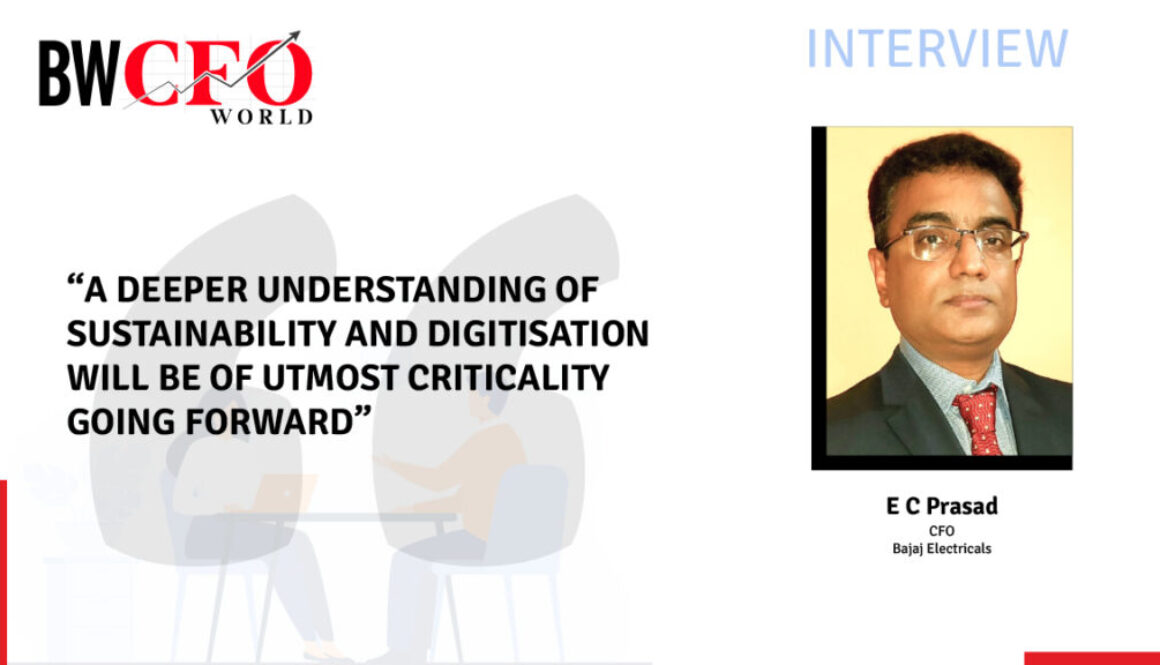Strategising For ‘Short Term Quick Fixes and Long Term Building Blocks’: E C Prasad, Bajaj Electricals
Prasad who has taken charge of the office of Chief Financial Officer and Key Managerial Personnel at Bajaj Electricals Limited from the beginning of this quarter shares his insights on the changes in the role of CFO he has observed.
As business activity resumes and CFOs emerge with more role definition, it becomes integral to build on the changes that have set in and will remain in the long run. E C Prasad, in an interview with the BW CFO World team, shared his insights on changing priorities, the need for setting up financial war rooms for timely responses and the evolving role of CFO. Excerpts from his interview:
As you continue transitioning into your role as CFO at Bajaj Electricals, what are some of your top priorities?
In such challenging times, the focus inadvertently tends to be on staying nimble. However, it is equally crucial to stay focused on long-term goals to achieve sustainable, profitable growth to mitigate the impacts and chart the future course of action. My top priority is to strike a seamless balance between these short-term and longer-term business goals in the current scenario. Some of the key vectors of the task at hand are- Portfolio Simplification, Prudent Capital Allocation, having a Sustainability Blueprint, Value creation for all stakeholders and Risk Management
What are some new/different practices you adopted since the pandemic that will earn a place in all plans going forward?
Resilience will be the topmost differentiator in this new dynamic environment that will determine the fate of an enterprise. With agility and a robust Business Continuity Plan at the core, some key practices that will be a part of our plans are –
Liquidity Management Office, where we continuously work on working capital management, meticulous planning, scenario building and adherence to financial discipline.
Establishing a Centre of Excellence to encourage best practices of Zero-based Budgeting, easy financing options (vendors, distributors) and outsourcing of non-core activities.
Identifying measurable risks, enhance coverage of cyber & crime policy
Leveraging digitisation and analytics to embrace all possible aspects viz. automation of business-as-usual (BAU) items, use of analytics and integration of insights for decision making
As the pandemic case count tapers to a temporary low, how do you see the strategies around spend management and cost-cutting to be impacted further on?
As the age-old adage goes, “In the time of crisis, CASH is KING,” which couldn’t be more relevant today. Businesses have adopted a very pragmatic approach since the onset of the pandemic, which will not change anytime soon. Irrespective of the number of cases and the ongoing uncertainties, we are likely to witness more proactive measures on prioritising productive spending while eliminating the non-productive ones; promoting performance-based culture via institutionalisation of Balance Scorecard (BSC) and a higher proportion of Performance Incentives and lastly, conducting an Awareness program on the importance of cash flow.
How do you infuse dynamism in the forecasting of quarterly and annual outlooks in a changing world?
A “War Room” comprising of cross-functional representations has been set up to ensure agility and fast response to address evolving issues. This is backed by stringent review mechanisms and active communications channels via the use of technology.
Given the speed of change for the past few quarters, for what period should an organisation plan its strategy? And what should be the pillars of a sound financial strategy?
Currently, strategic planning encompasses Short Term – Quick Fixes and Long Term – Building Blocks, as I like to coin it. A few active tactical fixes that are of immediate priority deal with commodity hikes, optimisation of cost structure, and limiting discretionary spending. In addition, the establishment of fundamental blocks such as product development, brand positioning, and innovation are also being pursued parallelly. While most of these strategies are guided by the concept of EVA at the macro level, the Cash Flow, Return Metrics, and Risk Management are also factored in various aspects of decision making.
From a risk management perspective, as the concern over cybersecurity looms, how can CFOs contribute to help mitigate the risk and be a partner with IT in staying ahead in a virtual world?
To mitigate risk in today’s virtual world, CFO’s can play the role of a benefactor by empowering their teams to implement technology & enhancements projects that can enable the protection of information. These include- implementation of a security operation centre; ensuring that intellectual data, information & critical business applications have cybersecurity insurance; and finally by facilitating policy & process standardization as per industry standards.
Learning from the pandemic, what are the new list of skills for the ideal CFO according to you?
From a skillset & competency perspective, it is tough to ringfence or zero down on one specific skill set; however, developing a deeper understanding of sustainability and digitisation will be of utmost criticality going forward. Needless to mention that understanding of financing, business, governance, digital domains convergence/linkage to doors of sustainability needs to be comprehensively understood.
Lastly, considering enhanced volatility, increased connectedness and global interdependencies, all companies need to have a structured Business Continuity Plan (BCPs) to counter adverse scenarios with greater grit and resolution.

